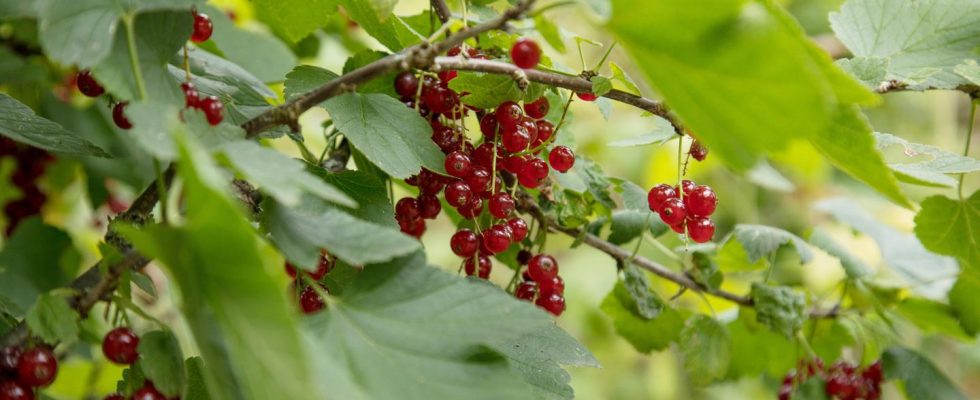Gardening tips
Cut currants: So that you can snack diligently again next summer
Small but mighty. Currants are not only delicious, but also healthy. So that the children can snack diligently again next summer, shoots must be cut off. And that’s how it works.
© Christin Klose / Picture Alliance
Fruit bushes are a must in any garden. The currant is particularly colorful. Anyone who loves the red, white or black fruits should take care of them now. And that’s how it works.
They are barely bigger than a pea, usually a bit sour and are a hit as jam on every Sunday sandwich. Currants are one of the most popular things the orchard has to offer in late summer. No matter whether classic red, deep black or white (and mild), as a stem or bush: currants (that’s what they are called in Austria) should not be missing in any garden. Because like many berries, currants are true all-rounders and cut a brilliant figure anywhere. On a summer cake, as jam, with a scoop of vanilla ice cream or simply for snacking. But if you want to pamper your child and family with delicious and very healthy currants next year, you have to do something about it. The yield depends primarily on when and how consistently the bushes are cut.
Read this article to find out why immediately after harvest with garden and pruning shears should arm which shoots are cut where have to and which ones differences it between black and red currants gives.
Find the right time
Currants usually ripen between June and August. Blackcurrants can usually only be harvested from July onwards. When the bush is empty and the jam is cooked, you shouldn’t waste too much time. At least not if the shoots are to bear plenty of fruit again next summer. Which brings us to the first criterion for cutting fruit trees in general and cutting currants in particular, namely the right time.
shrub | Time | Reason |
Fruit trees in general | December to March | promote new fruit wood (educational section) |
Fruit trees (summer cut) | July to September | Improve the quality and color of the fruit |
Important: Like almost all shrubs, currants should not be cut every year.
Tip: Shrubs, and therefore also the currant, are both a source of food and a habitat for birds. Some species look for safe shelter in the dense bushes or build nests for their offspring in hedge plants. Radical cuts to just above the ground are therefore only possible between October 1st and 28th/29th. February, i.e. outside the breeding season, permitted.

Golden Ratio Rules: Avoid extremes
Never forget that you are damaging the wood and therefore the bush as soon as you use it Garden or pruning shears go to work and cut off shoots. Therefore, watch the weather forecast before cutting the currants. If frost or extreme heat is expected in the following days, it is better to keep your feet still for a few days. Regardless of the temperature, shrubs should generally not be cut in direct sun. Cooler, cloudy days with some rain are perfect. Under these conditions, the cuts on the shoots heal best.
Cutting currants: fewer shoots, more fruit
Before you use the scissors, you should look at the shrub as a whole. All branches that grow from the ground are also called main branches. They develop side shoots on which the fruits of the currant are formed. As a rule, most of the berries ripen in the second and third years. After that, the main branches start to run out of steam. So find the three to four oldest main shoots and cut or saw them off near the ground. Leave a maximum of ten to twelve main branches under 4 years old. You should also separate some new ground shoots.
Important: The shoots must be completely removed.
Removing senescent main shoots and some young shoots not only gives the berries more space next year, but also the appropriate light they need to grow. In most cases, fewer shoots mean more fruit next year.
Cut side shoots: Let there be light
Once the old main shoots have been thinned out, turn your attention to the side shoots of the younger ground shoots, the so-called leading branches. Remove all branches to a height of about 40 centimeters. The berries will not ripen on these shoots anyway because of the lack of light. Branches that shoot up steeply can also be removed. They later take away the light from the berries and do not bear any fruit themselves.
And while you’re at it in the days after the harvest, if possible, cut off the side shoots that have borne fruit this summer. Leave each cone about a centimeter long. The new fruit shoots develop from this. They will bear berries again by the summer after next at the latest.
Important: Newly formed side shoots should only be cut if they are very close to one another. Because they secure next year’s harvest, only every second shoot should be cut down to one centimeter.
Cutting blackcurrants: This is important
In contrast to its red and white berry friends, the black currant bears the largest and most fruits on the annual shoots. The weakest can be consistently trimmed after the harvest and into September. In spring the main branches are then shortened above the second or third side shoots. There is no need to be squeamish even with the oldest and worn-out main shoots. Similar to the red and white variants, these are sawn off just above the ground.
Sources:My beautiful garden, Plantura
This article contains so-called affiliate links. Further information are available here.


